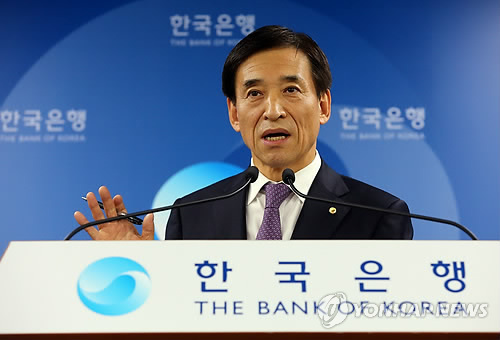Weak economic outlook calls for another rate cut: analysts
By Park Hyung-kiPublished : Aug. 4, 2016 - 15:57
Exports, South Korea’s main growth driver, dropped more than 10 percent in July, with imports decreasing faster than outbound shipments by 14 percent.
Low inflation below the 1.1 percent target on falling oil prices and slow industrial production driven by decreasing global demand continue to drag Asia’s fourth-largest economy.

With key statistical data pointing south, socioeconomic outlooks showing negative signs and doubts over the impact of the government’s stimulus proposal, market analysts are suggesting another option remaining at the Bank of Korea’s disposal -- a further rate cut.
“Given increased risks to global growth following the U.K.’s EU referendum, and HSBC’s forecast for a deceleration of European growth into 2017, we now expect two further rate cuts in the fourth quarter of 2016 and the first quarter of 2017, bringing the policy rate to a new historic low of 0.75 percent,” Frederic Neumann, economist at HSBC, said in a report.
Samsung Securities also said in its report that the central bank could move to “cut its key base rate to 1 percent in September or October," citing the latest BOK policy committee’s concerns over low consumer prices and currency appreciation, in addition to a slow economy.
The Organization for Economic Cooperation and Development said last June, “There is a case for further monetary easing, as inflation is still far below the new target (of 2 percent).” Moody’s Analytics suggested that “further easing is on the cards later in 2016,” should Korea’s economic conditions further deteriorate.
BOK Gov. Lee Ju-yeol mentioned that the current record low rate of 1.25 percent was accommodative enough to the planned fiscal stimulus, hinting difficulties in further decreasing borrowing costs as Korea already has high household debt.
The country’s household debt in proportion to its economic output has continued to climb, reaching about 90 percent last year, from 86 percent in 2014 and 80 percent in 2013. Meanwhile, household disposal income increased about 1 percent in recent fiscal quarters, compared with a 10 percent increase in household debt, according to HSBC data.
This suggests that Korea’s gross domestic product growth, in terms of domestic consumption or spending, is mostly fueled by household borrowings on low interest rates backed by monetary and fiscal stimulus, which could severely affect its socioeconomic fundamentals when the country faces the worst-case scenario.
Financial regulators have taken steps to curb rising household debt, which warrants a further rate cut as the global economy weakens. However, a lower rate comes with risk of facing years of market volatility like advanced economies have, which have had near-zero rates for almost a decade following the global financial crisis of 2008.
“Monetary decisions need to take into account risks to financial stability, including those stemming from household debt and capital flows,” the OECD said.
By Park Hyong-ki (hkp@heraldcorp.com)



















